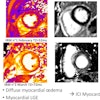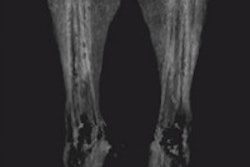High-quality coronary CT angiography (CTA) images can be obtained using single-beat, high-pitch, dual-source CT and ultralow contrast doses, potentially reducing the risk of contrast nephropathy in the bargain, according to a new study in European Radiology.
Applying their high-pitch dual-source protocol to 100 patients with suspected coronary artery disease, the researchers from Charité University in Berlin found they could achieve consistent arterial attenuation values of 300 Hounsfield units (HU) or greater with contrast volumes as low as 40 mL in men and 30 mL in women.
With careful contrast timing, contrast volumes as low as 30mL to 40 mL are "sufficient to achieve adequate arterial contrast enhancement in CTCA [CT coronary angiography] in selected, nonobese patients," wrote Dr. Alexander Lembcke, Dr. Carsten Schwenke, Dr. Patrick Hein, and colleagues. Even so, they added, "our study results support the general rule that longer [contrast media] injection periods with higher ... volumes result in proportionally higher arterial contrast enhancement" (Eur Radiol., 15 August 2013).
Permitting smaller doses
Ultrashort acquisition times owing to the use of advanced CT systems may permit far smaller contrast doses than are still typically used, the study team wrote.
"For example, second-generation dual-source CT allows high-pitch CT data acquisition, enabling acquisition of a complete volume dataset within a single heart beat, which is in less than 0.3 seconds," the authors wrote. "This represents a significant reduction in acquisition time compared with previous generations of CT systems acquiring a full dataset in typically 10-15 seconds."
The group hypothesized that such a fast acquisition would require only a short time window of coronary artery enhancement performed with a small contrast media dose without affecting image quality. The study was designed to assess CTCA image quality "across a range of different contrast media volumes in a uniform, nonobese European patient population with standardized imaging parameters," the group wrote.
Lembcke and colleagues enrolled 100 consecutive patients referred for coronary CTA; all weighed between 65 kg and 85 kg, with stable heart rates of 65 bpm or less. The patients were randomly assigned to one of five groups of contrast media volumes: 30 mL, 40 mL, 50 mL, 60 mL, or 70 mL of 370 mg/mL contrast media (iopromide, Ultravist 370, Bayer Healthcare). Contrast was injected at 5.0 mL per second followed by a 50-mL saline chaser, on a dual-head power injector.
Single-beat high-pitch protocol
Images were acquired on a second-generation dual-source CT scanner (Somatom Definition Flash, Siemens Healthcare) using a high-pitch ECG-gated protocol and bolus tracking with a region of interest placed in the left atrium and an attenuation threshold set to 100 HUs.
Images were acquired at collimation of 2 x 128 x 0.6 mm by means of a z-flying focal spot, with gantry rotation time of 280 ms, pitch 3.2, tube voltage of 100 kV, and reference tube current-time product of 370 mAs/rotation using automatic exposure control (CareDose 4D, Siemens). Data acquisition began at 60% of the RR interval with patients at mid-inspiration, the authors wrote.
A single skilled radiologist with 12 years' experience in cardiac imaging evaluated all of the images, measuring HU values within the lumen in different cardiovascular districts.
High attenuation, small contrast doses
Mean attenuation ranged from 345.0 (men) and 399.1 (women) HU in the 30-mL group to 478.2 (men) and 571.8 (women) HU in the 70-mL group -- higher in groups with higher contrast volumes and higher in women than in men, the group reported.
Patient weight -- as a cofactor or the distribution among the five groups -- had no significant effect on attenuation values (p = 0.2304 and p = 0.6717, respectively), Lembcke and colleagues wrote. But gender was a significant factor influencing the attenuation values, with higher values for women (p < 0.0001) -- and this result was found to be consistent over the different contrast volumes.
The reasons for the gender differences remain uncertain.
"In principle, it can be assumed that differences in blood volume and cardiac output between men and women may affect contrast enhancement," Lembcke et al wrote. "Also, the different body weight may cause differences between men and women. However, in our study neither the cofactor weight nor the distribution of weight among the five groups was found to have a significant effect on contrast enhancement."
The proportions of vascular segments with attenuation of at least 300 HU was 89% for the 40-mL group, 95% for the 40-mL group, 98% for the 50-mL group, 98% for the 60-mL group, and 99% for the 70-mL group, the team reported.
"Remarkably, we found an opacification gradient along the coronary arteries with lower attenuation values in the distal segments that is in accordance with previous reports," the group wrote, noting that the reasons for this phenomenon remained unclear.
Contrast media volumes of 40 mL and even 30 mL produced adequate image quality for confident evaluation of the coronary arteries, the authors wrote, noting the contrast protocol "appears to work well in normal weight or moderately overweight patients with a low heart rate, a regular sinus rhythm, and normal cardiac output."
Previous studies have suggested contrast doses as low as 40 mL to 50 mL in both 64- and 320-detector-row machines, but the studies were conducted in populations of Asians with a generally smaller body habitus than Western populations, the group noted.
Contrast boosts accuracy -- and risk
Many studies have shown how contrast media directly affects CTCA image quality and diagnostic accuracy. It has also been shown that higher intraluminal attenuation may improve the diagnostic accuracy of stenosis detection, although high attenuation can affect the delineation of calcified plaque.
"In fact, higher attenuation values can be achieved by administering higher volumes of CM [contrast media]," they wrote. However, the administration of higher CM volumes is associated with an increased, volume-dependent risk of [contrast-]induced nephropathy and consequently may raise morbidity and mortality. Furthermore, sudden exposure to high volumes of iodinated CM may cause incident hyperthyroidism and incident overt hypothyroidism."
Reducing contrast volume remains a core recommendation for reducing risk, the group noted. But while contrast volumes have been falling somewhat with the advent of new CT technologies, the basic principle of adapting the contrast protocol to the timing of the data acquisition had not changed much -- until it was turned on its head.
"This paradigm has now shifted to the strategy that the timing of CT data acquisition and delay should be adapted to a given CM injection protocol," they wrote. "The underlying traditional concept is based on the generally accepted rule that arterial contrast enhancement increases cumulatively with CM injection duration and that an injection duration of at least 10 s is always needed to achieve adequate contrast enhancement."
In single-beat high-pitch CTCA imaging there is an apparent discrepancy between snapshot-like acquisitions and relatively long contrast injections with their required large contrast volumes, they wrote.
"Irrespective of traditional concepts of CM administration, our study results indicate that shorter CM injection periods of 6 or 8 s seem to be sufficient for achieving an adequate opacification of the coronary arteries," Lembcke et al wrote.
Future research should be directed toward individually tailored low contrast-volume injection protocols to achieve consistent opacification independent of patients' body habitus, they concluded.



















